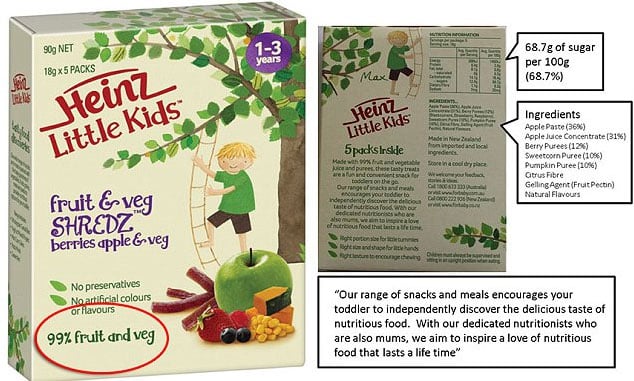In brief
The Federal Court has found that the packaging of the Little Kids Shredz children's food range, produced by food giant Heinz, was misleading to consumers because it suggested the high sugar products were nutritious and healthy. A claim that is objectively true, such as 'made from 99% fruit and vegetables', may still be misleading if its implication is misleading. Partner Richard Hamer and Lawyer Eliza Lockhart report.
How does it affect you?
For the food industry
- High-sugar fruit products are not 'healthy' or 'nutritious'.
- Claims that are literally true – here that the product has a high fruit and vegetable content – may be misleading if the implication is that the product is 'healthy' or 'nutritious'.
- Stating the substantial fruit and vegetable content risks the implication that a product is 'healthy' and 'nutritious'.
Generally
- The literal truth is not a defence if the overall impression is misleading.
Background
In June 2016, the ACCC commenced proceedings in the Federal Court of South Australia against H.J. Heinz Company Australia Ltd, alleging that Heinz made misleading representations in relation to its 'Little Kids Shredz' product line. Shredz is a children’s food, intended for ages one to three.
The ACCC's complaint focused on the prominent depictions of fresh fruit and vegetables on the Shredz packaging, along with statements made on the packaging such as '99% fruit and veg', and '[o]ur range of snacks and meals encourages your toddler to independently discover the delicious taste of nutritious food'.
In summary, the ACCC alleged that the images and statements on the Shredz packaging represented that the products:
- were of equivalent nutritional value to fruit and vegetables, which was false because they were more concentrated in terms of sugar content and energy than natural fruit;
- were a nutritious food and are beneficial to the health of children aged one to three years, which was false because the products were high in sugar; and
- encouraged the development of healthy eating habits for children aged one to three years, which was false because the high sugar content was likely to inhibit the development of a child's taste for natural fruit and vegetables.
Justice White of the Federal Court found that the ACCC had not established that the Shredz products represented to consumers that they were of equivalent nutritional value to fruit and vegetables, or that the products encouraged the development of healthy eating habits in children.
However, Justice White accepted the ACCC's second argument, holding that the combination of imagery and words on the Shredz packaging conveyed to ordinary, reasonable consumers a representation that the product was healthy and nutritious. His Honour held that this representation was misleading because the sugar content of the product was more than 60 per cent and therefore the product could not be considered beneficial to the health of children aged one to three years.
A hearing on penalties will be held at a later date.
Why is this decision important?
One of the striking features of this case is that none of the claims made on the Shredz packaging, when taken individually, appear to be inaccurate. The key statement displayed prominently on the front of the package – that the product is made with or from 99 per cent fruit and vegetable purees – is accurate when examining the ingredients list.
It has been long established that a literally correct statement can convey a misleading impression and, furthermore, that this impression can be conveyed through the combined effect of several elements of a piece of advertising.
Justice White's conclusion that the combination of imagery and words on the packaging conveyed the representation of 'nutritiousness and health', 'naturalness and goodness', despite the fact that the packaging did not make any express claim to the effect that the product was healthy, can be seen as a new extension of this position.
What is significant is that the packaging's allusions to nutrition and health were challenged by the ACCC solely on the basis that this was inconsistent with the sugar content of the product. The acceptance of this argument by Justice White indicates that, going forward, the ACCC will take a dim view of the health claims made by high-sugar food products.
A taste of things to come?
This case is the first shot in what is likely to become a protracted battle to define the edges of acceptable advertising of high-sugar foods. In our previous Food Law Bulletins, we have warned that sugar has emerged over the past decade to become the leading nutrient of concern in many jurisdictions. Indeed, Heinz's Shredz products were brought to the attention of the ACCC through a complaint made by the Obesity Policy Coalition. The Coalition is a lobby group comprised of the Cancer Council Victoria, Diabetes Victoria and Deakin University, which seeks to influence food labelling and advertising rules. The Obesity Policy Coalition is on the forefront of the movement to regulate sugar in diets (particularly sugary drinks) and, we suspect, their policies have had a strong influence on the ACCC’s allegations against Heinz.




